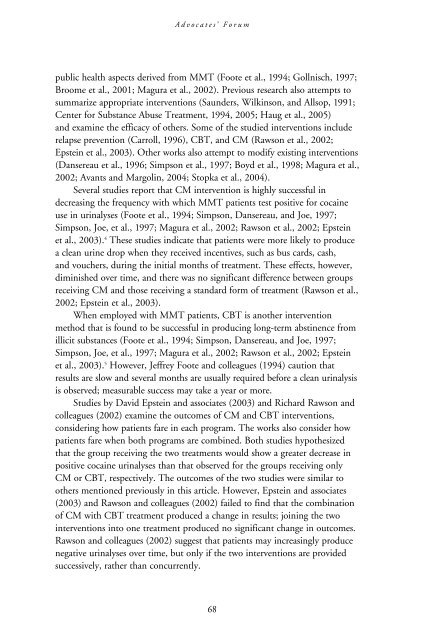2006 - School of Social Service Administration - University of Chicago
2006 - School of Social Service Administration - University of Chicago
2006 - School of Social Service Administration - University of Chicago
Create successful ePaper yourself
Turn your PDF publications into a flip-book with our unique Google optimized e-Paper software.
Advocates’ Forum<br />
public health aspects derived from MMT (Foote et al., 1994; Gollnisch, 1997;<br />
Broome et al., 2001; Magura et al., 2002). Previous research also attempts to<br />
summarize appropriate interventions (Saunders, Wilkinson, and Allsop, 1991;<br />
Center for Substance Abuse Treatment, 1994, 2005; Haug et al., 2005)<br />
and examine the efficacy <strong>of</strong> others. Some <strong>of</strong> the studied interventions include<br />
relapse prevention (Carroll, 1996), CBT, and CM (Rawson et al., 2002;<br />
Epstein et al., 2003). Other works also attempt to modify existing interventions<br />
(Dansereau et al., 1996; Simpson et al., 1997; Boyd et al., 1998; Magura et al.,<br />
2002; Avants and Margolin, 2004; Stopka et al., 2004).<br />
Several studies report that CM intervention is highly successful in<br />
decreasing the frequency with which MMT patients test positive for cocaine<br />
use in urinalyses (Foote et al., 1994; Simpson, Dansereau, and Joe, 1997;<br />
Simpson, Joe, et al., 1997; Magura et al., 2002; Rawson et al., 2002; Epstein<br />
et al., 2003). 4 These studies indicate that patients were more likely to produce<br />
a clean urine drop when they received incentives, such as bus cards, cash,<br />
and vouchers, during the initial months <strong>of</strong> treatment. These effects, however,<br />
diminished over time, and there was no significant difference between groups<br />
receiving CM and those receiving a standard form <strong>of</strong> treatment (Rawson et al.,<br />
2002; Epstein et al., 2003).<br />
When employed with MMT patients, CBT is another intervention<br />
method that is found to be successful in producing long-term abstinence from<br />
illicit substances (Foote et al., 1994; Simpson, Dansereau, and Joe, 1997;<br />
Simpson, Joe, et al., 1997; Magura et al., 2002; Rawson et al., 2002; Epstein<br />
et al., 2003). 5 However, Jeffrey Foote and colleagues (1994) caution that<br />
results are slow and several months are usually required before a clean urinalysis<br />
is observed; measurable success may take a year or more.<br />
Studies by David Epstein and associates (2003) and Richard Rawson and<br />
colleagues (2002) examine the outcomes <strong>of</strong> CM and CBT interventions,<br />
considering how patients fare in each program. The works also consider how<br />
patients fare when both programs are combined. Both studies hypothesized<br />
that the group receiving the two treatments would show a greater decrease in<br />
positive cocaine urinalyses than that observed for the groups receiving only<br />
CM or CBT, respectively. The outcomes <strong>of</strong> the two studies were similar to<br />
others mentioned previously in this article. However, Epstein and associates<br />
(2003) and Rawson and colleagues (2002) failed to find that the combination<br />
<strong>of</strong> CM with CBT treatment produced a change in results; joining the two<br />
interventions into one treatment produced no significant change in outcomes.<br />
Rawson and colleagues (2002) suggest that patients may increasingly produce<br />
negative urinalyses over time, but only if the two interventions are provided<br />
successively, rather than concurrently.<br />
68
















